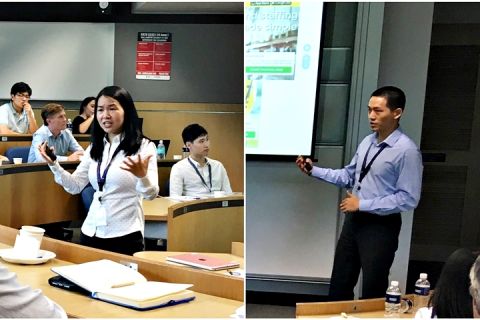Above: Prof Phang Sock Yong speaking at the SMU Centre for Research on the Economics of Ageing (CREA) 3rd Roundtable on Housing
By Rebecca Tan
SMU Office of Research & Tech Transfer – For the pragmatic Singaporean, asking your significant other whether you should apply for a Housing & Development Board (HDB) flat together can sometimes stand in for a marriage proposal. As unsentimental as this approach to life may seem, it is perhaps still not practical enough; few young couples consider the impact of their housing choices on their retirement lifestyles 30 or 40 years down the road.
And yet the percentage of wealth a person has locked up in housing can have profound implications on his or her readiness for retirement, a particularly precarious stage of life. Having too much of their net worth invested in low-liquidity assets like housing can sometimes leave retirees unable to deal with health shocks or other financial crises that arise.
There is reason to believe that older Singaporeans could do more to unlock the value of their homes, according to data from the Singapore Life Panel® (SLP), the largest internet-based, high-frequency survey of health and household economics in the world. The SLP is the flagship project of the Singapore Management University’s (SMU) Centre for Research on the Economics of Ageing (CREA), and has been collecting detailed data from nearly 12,500 Singaporeans aged 50 to 70 every month.
Home is where the money is
At a roundtable on housing held on 16 August – the third of four such discussions planned for 2017 – SMU researchers shared their preliminary findings with analysts and policy makers from various housing-related agencies in Singapore, including HDB, the Ministry of National Development and the Urban Redevelopment Authority.
“The SLP gives us insight into the asset portfolios of the respondent households,” said Assistant Professor Li Jing of SMU’s School of Economics. “It has detailed information on each component of the total household wealth: home equity, Central Provident Fund (CPF) balance and other non-housing wealth.”
By analysing the SLP data by overall wealth distribution, Professor Li found that housing equity forms the bulk of an individual’s wealth for most Singaporeans. “For the 30th percentile on the wealth distribution, more than 80 percent of their wealth is in the form of housing,” she said. “The average ratio of housing to non-housing equity is significantly larger than that of other countries.”
However, the situation is quite different for the bottom ten percent of the population, she added. These low-income households have most of their wealth in the form of CPF and only six percent of their wealth in the form of housing equity, most likely because they do not own their own homes.
“These figures suggest that policies such as wealth transfers and unlocking their CPF balances would be more helpful for the bottom 10th percentile, while the 30th to 50th percentile should be encouraged to monetise their homes to finance retirement,” Professor Li said.
Ready or not, here retirement comes
One reason home owners might want to monetise their homes is to prepare for retirement. As part of the data collection for SLP, respondents were asked to rate their own financial preparedness for retirement from poor to excellent. Through a regression analysis, Professor Li found that having a high ratio of home equity was linked to feeling financially unprepared for retirement.
“The pattern was striking; the value of non-housing assets plays a larger role in explaining financial readiness than home equity. This highlights the necessity of monetisation policies,” she said.
Although there is a need for people to monetise their housing for retirement, Singaporeans have been loath to take up the monetisation options available to them, said Professor Phang Sock Yong. Professor Phang is SMU’s Vice Provost (Faculty Matters) and the Celia Moh Chair Professor of Economics. She is also a senior research fellow at CREA.
Owners of HDB flats have three main options when it comes to monetising their homes: subletting, downsizing to a smaller unit, and the lease buyback scheme which was introduced in 2009.
“Our data shows 17% of households in the sample (aged 50 to 70) enjoy some form of rental income from property ownership. There is limited downsizing; 79 percent of households have lived in their present house for more than ten years, so mobility is rather limited.”
“As for the lease buyback scheme, only about one percent of eligible households have signed on, despite an enhancement package that was announced in 2013. The low take-up rate could be related to the past failure of reverse mortgages which ceased to be offered from 2009. Singaporeans generally have a very negative impression of reverse mortgages because products in the past were designed with very unfavorable terms for the homeowner,” she explained.
More options for monetisation
In agreement with the low take-up rate for the lease buyback scheme observed in the general population, the SLP data showed that only 1.8 percent of the eligible households were more than 40 percent likely to participate in the lease buyback scheme.
The lease buyback scheme and reverse mortgages have been unpopular for three main reasons, added Professor Kwong Koon-Shing from SMU’s School of Economics. First, they leave no bequest for the estate; second, they require the person to move out should they outlive the terms of their lease; and third, they effectively remove people from the property market, preventing them from benefiting should the price of their house increase.
Together with his colleague Professor Tse Yiu Kuen, Professor Kwong came up with a product that potentially addresses all three issues. “You can consider it a combination of the lease buyback and reversion schemes,” he explained. “At the beginning it looks like a reversion scheme where you sell a percentage of the house to get a fraction of the cash value, and the difference is used to fund the rental income. The difference is that the person is allowed to continue staying in the house until death, as the additional cost to do so is very low.”
Such innovative schemes give people facing retirement much needed options to fund their lifestyles, said Professor Phang.
“It appears that households in the SLP would prefer more channels of housing monetisation other than the lease buyback scheme. It might be necessary to populate the policy space with a lot more possibilities for monetisation to meet this need, such as retirement condominiums, retirement real estate investment trusts and so on,” she concluded.
See More News
Want to see more of SMU Research?
Sign up for Research@SMU e-newslettter to know more about our research and research-related events!
If you would like to remove yourself from all our mailing list, please visit https://eservices.smu.edu.sg/internet/DNC/Default.aspx

